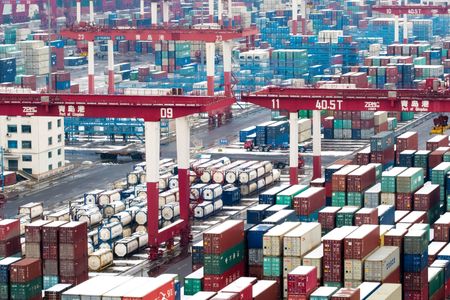
BEIJING (Reuters) -China’s exports grew at their fastest pace in five months in June, as factories revved up after the lifting of strict COVID lockdowns, but a slowdown in imports and a darkening global backdrop pointed to a bumpy road ahead for the domestic economy.
Analysts say the rebound in exports reflects the easing of supply chain disruptions and port congestion that hammered the economy in prior months when the government rolled out widespread anti-virus measures.
Outbound shipments in June were 17.9% higher than a year earlier, the fastest growth since January, official customs data showed on Wednesday, compared with a 16.9% annual gain seen in May and quicker than analysts’ expectations for a 12.0% rise.
“This jump reflects the easing of supply chain disruptions coming out of lockdowns and, most importantly, fewer bottlenecks at ports,” said Julian Evans-Pritchard, senior China economist at Capital Economics.
“Although total container throughput at Chinese ports was little changed last month, the recent weakness of domestic shipping demand has freed up more port capacity for foreign trade,” he said.
Daily container throughput in June at Shanghai port, which had earlier been severely affected by a lockdown, had recovered to at least 95% of the same level a year earlier, according to official data.
Exports of autos contributed to the robust growth. China exported 248,000 units of vehicles in June, up 30.5% from a year earlier, customs data showed.
However, economists say the strength in exports is likely to fade as rising global interest rates to rein in inflation sap consumption and broad economic growth.
The threat of further pandemic restrictions at home also hangs over businesses and households, while the Ukraine war has put renewed pressure on world supply chains.
China’s foreign trade still faces instability and uncertainty, said Li Kuiwen, a spokesman for the General Administration of Customs, at a news conference in Beijing on Wednesday.
Zhiwei Zhang, chief economist at Pinpoint Asset Management, said that while foreign trade continued to be the “best performing engine of the economy,” the outlook points to “a bumpy road with disruptions.”
“As the demand in the developed countries shifts towards services from goods, the strong export growth may not be sustainable in the second half of the year. The current (COVID)outbreak in Shanghai and some other cities again cast uncertainty to the economic recovery in Q3,” Zhang added.
UPSWING TEMPORARY?
Thanks to government stimulus measures and the lifting of lockdowns, China’s economy entered an upswing last month. It suffered a severe slump in April as the country grappled with its biggest COVID-19 outbreak since 2020.
Official and private surveys show the country’s factory activity shook off three months of declines in June.
Wednesday’s customs data showed June imports had inched up 1.0% from a year earlier, slowing from May’s 4.1% gain, weighed down by the lockdown-induced slackening in commodity imports and subdued domestic consumption. Analysts had forecast a 3.9% rise.
China’s daily crude oil imports in June fell 11% from a year earlier to their lowest since July 2018, as refiners anticipated slackening fuel demand amid still tough COVID-19 restrictions.
Soybean imports also fell 23% from a year earlier as high global prices curbed appetite for the oilseed.
China posted a trade surplus of $97.94 billion last month, versus analysts’ forecast for a $75.70 billion surplus and a $78.76 billion surplus in May.
Policymakers plan to sharply boost spending on infrastructure, but economists are doubtful that gross domestic product will meet the government’s 5.5% target for this year without doing away with its strict zero-COVID strategy.
While pressure builds from a softening global backdrop, a shaky property market and soft consumer spending at home mean China’s domestic engines of growth also remain underpowered.
Adding to the headwinds, the highly transmissible BA.5 Omicron sub-variant has been found in several cities over the past week.
As of Monday, 31 cities – making up 17.5% of China’s population and 25.5% of GDP – have implemented full or partial lockdowns or some control measures at district level, Nomura analysts said in a note.
China is due to release its second-quarter GDP data on Friday.
A Reuters poll showed the GDP likely grew 1.0% in the April-June quarter from a year earlier, suggesting policymakers may have to do more to spur a faster recovery.
(Reporting by Stella Qiu, Ellen Zhang and Ryan Woo; Editing by Bradley Perrett & Shri Navaratnam)

